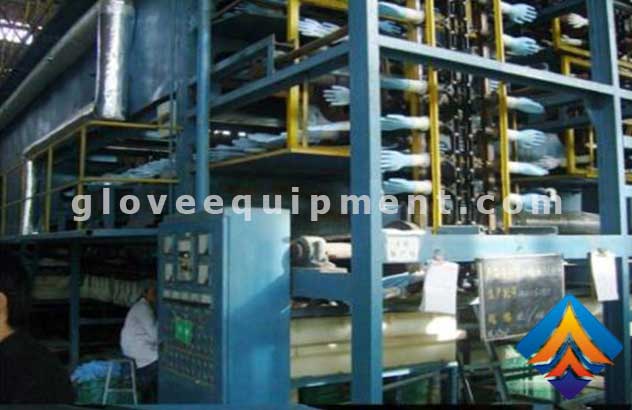Latex gloves are a kind of gloves, which are different from ordinary gloves and are made of latex. It can be used in household, industrial, medical, beauty, and other industries, and is a necessary hand protection product. The latex gloves are made of natural latex and matched with other fine additives. The products have a special surface treatment and are comfortable to wear. They are widely used in industrial and agricultural production, medical treatment, and daily life.
The rubber is first sliced by a rubber mixing machine and then sent to a sol tank to mix with gasoline for sol. After the sol is emulsified and prepared, it is pumped to the latex intermediate tank. The rubber solution dissolved in gasoline is fed from the top of the distillation tower, and is heated and distilled by steam. The light component gasoline is heated into a gas phase, and the gasoline gas is mixed and cooled by cold water in the oil-air cooler. The oil-water mixture then goes to the oil-water separator, the oil-water layer. The upper layer of gasoline is recovered, and the lower water is pumped to the cooling tower for cooling. After cooling, the gas gasoline in the distillation tower is cooled; the latex of the distillation tower is sent to the latex mixing cylinder to stir and modulate to the centrifuge to separate the glove material latex. Set aside after toning and filtering.
Punching Hand Moulds Base is first cleaned with acid and alkali and washed with water. The cleaned model is first immersed in hot water and heated until it is dipped in coagulant and dried for dipping. After dipping, it is sent to an oven for preliminary drying, adding fiber inner sleeve, flushing hot water, and then sending it to the oven for curing and drying to form. After the gloves are demolded, they are inflated, checked, shaped at low temperature, dried at medium temperature, washed with water, dehydrated, dried, and then packed and sent to the finished product warehouse.
Main pollutants
1) Mold washing wastewater and glue-containing wastewater generated in the washing process of each production line; (2) A small amount of ammonia gas generated during the production process; (3) dust generated in the drying process; (4) SO2, NOx, particulate matter, etc. generated during boiler operation Air pollutants; (5) SO2, NOx, particulate matter and other atmospheric pollutants generated during the operation of the standby diesel generator set; (6) Waste materials generated during the production process; (7) Sludge generated by the sewage treatment station, etc.
Approach
The water treatment process adopts physicochemical, biological contact oxidation method, and activated carbon adsorption. The technological process consists of the mechanical grille, regulating tank, air flotation tank, biological contact oxidation tank, sedimentation tank, sand filter, and activated carbon filter, fan room, etc. The waste gas treatment process is dedusted by the Venturi granite dust collector and then reacts with alkali-containing water to desulfurize and remove dust.
Features
Latex gloves are suitable for automobile manufacturing, battery manufacturing; glass fiber reinforced plastic industry, aircraft assembly; aerospace field; environmental cleaning, and cleaning. Latex gloves have abrasion resistance, puncture resistance; resistance to acids and alkalis, grease, fuel, and various solvents, etc.; they have a wide range of chemical resistance and good oil resistance; they have passed FDA certification. Latex gloves feature a unique fingertip texture design, which greatly enhances the grip and effectively prevents slippage; the patented design without palm lines, evenly penetrates the glue, and enhances protection; the unique hand design, cotton lining, improves comfort.
Material
Gloves are divided into cotton yarn, plush, leather, etc. according to the material. The commonly used material for making gloves is fiber.
Lining material—heat protection design PVC
Point plastic—the best non-slip solution
PU or latex coating—suitable for the oily or oily environment.
Several commonly used glove materials:
(1) Metal wire-common stainless steel wire, also chrome alloy wire, mainly used to make cut resistant gloves. This type of material has the strongest cutting resistance and is easy to clean, but it is heavy and inconvenient to use.
(2) Kevlar, Spectra, and other synthetic yarns-they are also better synthetic fiber cut-resistant materials. Although the cut-resistant ability is not as good as metal wire, they are light in weight and comfortable to use. After improvement and treatment, some products can also achieve cut-resistant products. The highest level of the standard.
(3) Nitrile (with fabric lining)-with anti-wear and anti-puncture properties, flexible and comfortable to use.
(4) Natural latex (with fabric lining)-it has excellent elasticity, especially flexibility, and has certain anti-wear, tear, and cut properties.
(5) PVC (with fabric lining)-can provide a certain degree of wear and puncture protection, if the material is thicker, it can also have a certain resistance to cutting, but not tearing.
(6) Leather-natural material, through various tanning treatments, with unique properties. Leather can be divided into cowhide, which has the advantages of comfort, durability, breathability, and wears resistance. After chrome ravages, it is more durable and resistant to high temperatures; pigskin has large pores and has the best air permeability. It can still maintain well after washing. Sheepskin is the most comfortable, durable, and wear-resistant, but because it is too expensive, it is generally only used in industries that require high tactility.

Latex gloves
Why do medical latex gloves have powder?
Medical sterile rubber gloves are generally made of natural rubber. The powdered gloves and powder-free gloves are actually changed for the convenience of putting on and taking off. Because the corn starch or talcum powder in the powdered gloves is easy to adhere to the soluble protein on the gloves, it is easy to People who are allergic to natural rubber are allergic, and powder-free gloves are generally treated with chlorine, which is not easy to cause allergies. So both powder gloves and powder-free gloves can wash dishes.


